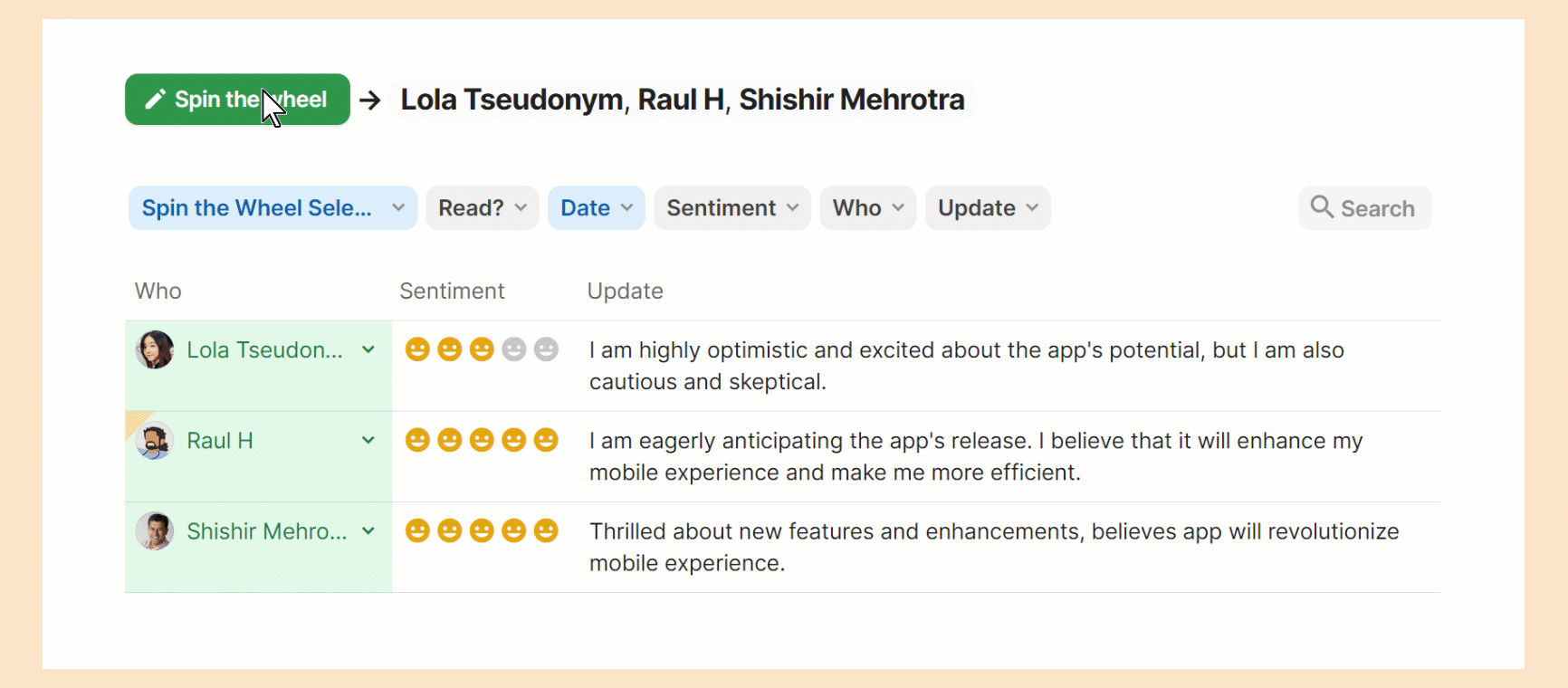Skip to content

 The art of the multi-threaded meeting
The art of the multi-threaded meeting
Four practical ways to transform a boring, inefficient, single-threaded meeting into an efficient, engaging, multi-threaded meeting.
“Hey, how do you actually run a multi-threaded meeting?”
A few weeks back I gave a talk at with Figma CPO, Yuhki Yamashita, on Rituals of Great Product Teams. The talk was a lot of fun to give and generally well-received.
One of the topics we covered drew a lot of feedback: the idea of a “multi-threaded meeting,” inspired by a ritual called Bullpen from my time at YouTube. This idea turned out to be quite resonant––easily the most asked-about topic after the talk.
It came up again in a followup discussion a couple weeks later when I met with Jon Alferness (CPO, Walmart) and Aisling Robins (VP Product Strategy, Walmart). We spent a lot of time discussing the Walmart rituals, which I’ll cover in a different post. Jon asked me a provocative question:
“I love the idea of a multi-threaded meeting, but in practice, it seems so difficult to implement. How do you actually run a multi-threaded meeting?”
As I was writing up my reply to Jon, I realized that this topic is likely interesting to many others, so I decided to turn my reply into a post instead.
But first: What is a multi-threaded meeting? Why does it matter, and why is it hard?
Before getting to the practical considerations, let’s back up and clarify the concept.
I picked up the term “multi-threaded meeting” from my friend and mentor, Reid Hoffman. He hosts really fun dinners, and whenever he does, he lets me know in advance if it’s going to be single-threaded or multi-threaded. I’m sure you can picture the difference––a single-threaded discussion has one topic at a time. Everyone pays attention, and if you want to change the topic, you have to change it for everyone.
But think about when you have a multi-threaded event, you might picture a conference or a happy hour. Everyone splits into small groups and many topics are discussed at once. Reid has very different formats for single-threaded dinners vs multi-threaded dinners. For example, he chooses one round table for single-threaded, and prefers many standing tables and a buffet for multi-threaded.
It turns out that most of our work meetings are naturally single-threaded. Interestingly, this creates a cascade of perverse side effects. You end up discussing only “majority topics” (topics that a majority of attendees would engage in). This then leads to creating substantially more meetings, as each sub-group of attendees needs their own forums. Also, since a single threaded forum can’t be driven by multiple parties, you increase the “loudest voice” effect.
But despite all these cons, single-threaded meetings are the default “best practice” for teams. All the meeting pundits implicitly advocate for it: have a single agenda, be clear on your goal, keep everyone focused on one task at a time. Meeting rooms are structured with a single table, side chatter is quickly shut down as interruptive. And as teams became more distributed, we replicated these behaviors in Zoom, where we highlight one speaker at a time, and “raise hands” to ensure a steady progression of the single-threaded agenda.
But I think there’s a better way.
Four rituals for running multi-threaded meetings
Over the years, I have become a bigger and bigger proponent of building multi-threaded meetings into your team culture. It started with my adventures with YouTube Bullpen (more on this below), but as I worked with more and more teams using Coda, I discovered and adopted (read: shamelessly stole) multi-threaded techniques from many teams. There are countless examples, but I have four favorites that I would recommend to any team.
Ritual 1. : Schedule mini-topics to be held in parallel in a single meeting.
Bullpen was a really popular format that got rid of a bunch of other standing meetings and also absorbed many of the annoying ad-hoc meetings that were impossible to schedule. We started running them multiple days per week, and the ritual quickly spread throughout Google and to other companies as well. Read more of the story in .
Interestingly, when we started Coda, we wanted to create a similar format, but we had a challenge—we were a distributed team, so just putting everyone in “one room and letting groups self-form” wasn’t going to work. We ended up building a new process that has scaled well for us. People list out topics and indicate who they need and a guess at the length. It even has a fun way to highlight conflicts so people can order discussions.
Because we run Bullpen in a table, we’ve been able to measure the impact. This image is from a Bullpen last week where the group covered 30 topics in a single hour: the true value of being multi-threaded:


Example screenshot of Bullpen meeting with 30+ topics running in parallel
This is definitely the simplest multi-threaded meeting format to start with - just drop the single-threaded agenda, and let small group topics self-assemble into many parallel discussions. You can try a version of YouTube’s Bullpen using the template.
Ritual 2. : Everyone silently reads and comments on each other’s updates.
As one of the first fully-distributed companies, Zapier’s culture adapted distinct rituals from their early days. One of their most iconic is how Wade Foster, CEO, runs his weekly staff meeting.
He told me that it’s quite common that the page quickly fills up with comments with different team members going back and forth on topics in parallel. To use our terminology from above, Wade uses Silent Health Checks to convert his staff meeting from single-threaded to multi-threaded.
I loved this ritual and adapted it, with a small twist, in my extended staff meeting at Coda. This is one of my favorite meetings as it involves the top ~35 leaders at the company and often leads to some of our most interesting discussions. And like many Coda meetings, it’s natural to start with Pulse. Just like Zapier, we dedicate the first 10 minutes to silently reading everyone’s Pulse, and leaving comments back and forth. But we also added a Read? reaction and default filtered the table to only show the rows that each person hasn’t read. This creates a “feed” for each person to read, and we wait to start the meeting when everyone has read each other’s updates.
Here’s a video of how our adapted version of Wade’s ritual works 👇:


Example of Silent Reading: With a Read? button to ensure everyone reads/comments on each other’s updates.
This format has been a very effective “multi-threaded” format for us — often see many topics silently discussed and resolved in parallel, without any live discussion at all! Head to to copy the template.
Ritual 3. : Everyone prepares, random subset presents.
Like many companies, Stripe has an Incidents Review meeting that walks through post-mortems of that week’s events.
From an efficiency perspective, the discussion stays single-threaded, which is especially important in this meeting, as they really want everyone’s attention. But because everyone has to be prepared (you never where the wheel will land!), Spin the Wheel has a similar impact to a multi-threaded discussion in that the team has prepared thoughtful post-mortems on many more topics than they will go through.
Culturally, Spin the Wheel sends a clear signal that one of Stripe’s #1 customer expectation is insanely high-level reliability. If that’s the focus, teams want a signal of all the issues. No incident it too small. And in that way, Spin the Wheel is a ritual that reinforces a key cultural touchpoint.
We adapted into a number of meeting formats at Coda using a button to Spin the Wheel. Here’s an example of how we merged it with the Zapier Silent Health Check method: 👇


Example Spin the Wheel meeting: The button selects 3 people randomly and highlights their updates for discussion.
Ritual 4. : Remove standing attendees, and run independent forums in parallel.
This is the most extreme, but most effective multi-threaded technique I’ve seen. One of our PM leads, David Kossnick, wrote about our core decision making forum in .
He started with an odd observation: if you want to 10x your decision volume, you need to eliminate standing attendees.
Coda Catalyst solves both these issues with a new pattern: no standing attendees. Here’s how it works:
All of a sudden, instead of covering one to two topics per day, we cover 10+ topics! Each of them have the exact group that is necessary—no more, no less. Here’s a video of how it works: 👇
Example of Catalyst multi-threaded setup with a separate calendar event created for each Catalyst topic.
Note: while this ritual has some similarities to Bullpen, it turns out to feel quite different in practice, mostly due to the “unique calendar event per topic” set up for Catalyst. Bullpen tends to feel like lighter, just-in-time discussions with the people you need to connect with. Catalyst tends to feel more like a formal review meeting — with designated roles, clear prep, and a distinct time slot.
There’s a great template for this ritual in David’s doc: .
Bonus. : Put Rituals 1+2+3 together!
At Coda, I run my staff meeting with a mix of the first 3 rituals, so I’ve included a Bonus Template that ties all 3 of those together into a single system: . That way everyone adds one set up of updates that flows through from the Silent Health Check, to Spin the Wheel, and many of the comments naturally turn into topics in the Bullpen topic list.
Note that we run Ritual 4: Catalyst, as a separate forum.
Give it a try!
I’ve included templates for each of the four rituals in this doc: , , , (as well as the ).
And if you want to learn about more rituals, head over to and/or signup for my newsletter at
Want to print your doc?
This is not the way.
This is not the way.

Try clicking the ⋯ next to your doc name or using a keyboard shortcut (
CtrlP
) instead.